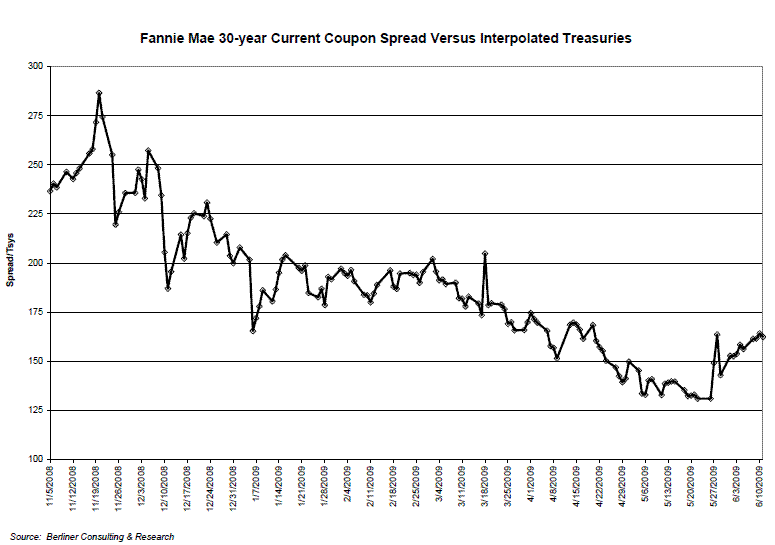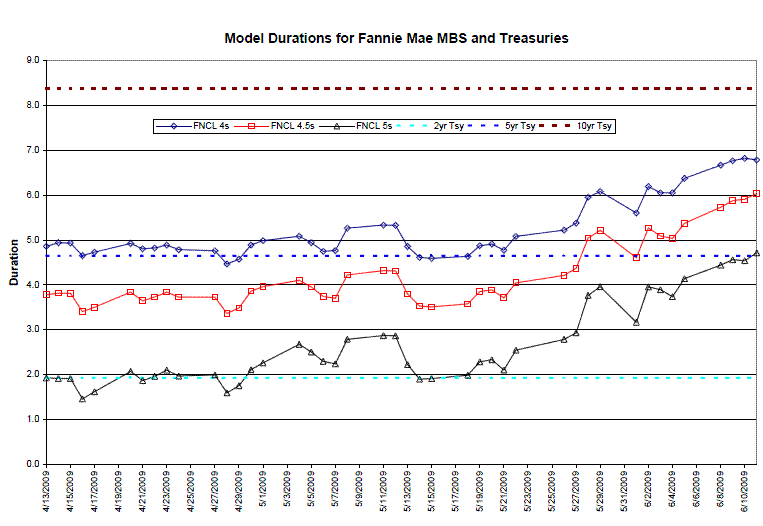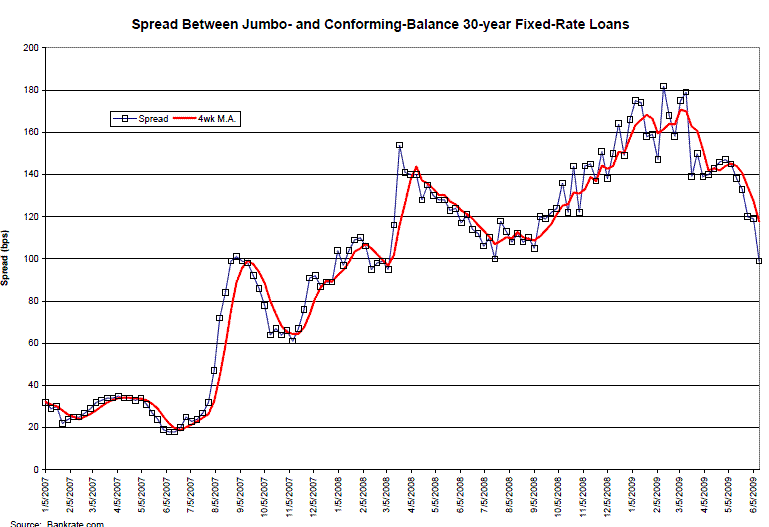It was another rough ride in fixed income markets last week, Treasury prices slumped, MBS bids deteriorated, and mortgage rates continued to move higher. As of Thursday's close, the Bankrate.com national average for 30-year fixed-rate conforming-balance loans was 5.70%, a 20 basis point increase from the prior week and 70 basis points higher than its level approaching the Memorial Day holiday.
Aside from rising Treasury yields, mortgage rates were pushed higher by widening MBS spreads, at least versus Treasury yields. The chart below shows the spread of the Fannie Mae current coupon rate versus interpolated 5- and 10-year Treasuries. Since the Memorial Day holiday, the current coupon has widened by almost 30 basis points after tracking Treasuries fairly well in the early phases of the Treasury market selloff.
I've talked in the past about duration extension and the lengthening of MBS empirical durations (i.e., the measure of daily changes in bond prices to changes in yields). The below chart shows "effective" duration calculations from a widely-used valuation model for Fannie 4s through 5s. (For the record, the model used is YieldBook, originally a product of the Salomon Bros. trading operation and now owned by Citigroup.) There are a few notable elements to this chart. One is that, between early April and late May, Fannie 4s had durations roughly equivalent to the 5-year Treasury. Since the selloff picked up steam after Memorial Day, the duration of 4s is now closer to the 10-year Treasury than the 5-year. Over the same period, the duration of Fannie 5s has gone from being roughly equal to the 2-year Treasury to equivalent to the 5-year. The duration extension is the result of slowing prepayment projections generated by pricing models, resulting from the sharp backup in Treasury and mortgage rates that began in early May.
Another development over the past few months is the tightening of the spread between conforming and jumbo-balance rates. The attached chart shows the spread, using rates obtained from Bankrate.com's web site, through the end of last week. However, that spread has narrowed further over the past week, and ended the week around 100 basis points, the tightest level in roughly a year. (Prior to the onset of the credit crisis, that spread was normally in the area of 25 to 37 basis points; from the beginning of January 2002 through the end of July 2007, the spread averaged 26 basis points.)
The recent tightening in the jumbo/conforming spread has arguably been influenced by changes in how jumbo loan pricing is calculated by most lenders. Pricing for agency-ineligible loans used to be generated by looking at execution into private-label (non-agency deals). (A detailed discussion of the jumbo loan pricing process, and its implications, can be obtained from a report I co-authored in 2008, "The Interaction of MBS Markets and Primary Mortgage Rates." The report can be accessed HERE) Since private-label deals can't be executed economically at this time, jumbo loans are generally priced to the assumption that they will be held in loan form in the lender's portfolio. Pricing for these loans is generated by backing into the required points for each rate level using some form of an ROE target, taking into account the institution's leverage and its costs of funds.
This suggests that jumbo rates are not directly driven by capital market levels, as they were in the past. Rather, they are dictated by institution-specific variables, mainly the ROE target. This suggests that jumbo rates are much less responsive to changes in market bond yields than conforming rates, as pricing for this protect is, in most cases, set by committee. If true, it also accounts for the sharp contraction in the spread between jumbo and conforming loans in the recent selloff.
It remains to be seen whether many lenders will see fit to raise jumbo rates over the summer, in order to restore the relationship between jumbo and conforming rates to its recent levels. A related question is whether pricing in the private-label MBS market will improve to the point where new-issue execution becomes economical. Levels in some sectors of the non-agency MBS market have improved dramatically over the past few months; for example, some bonds backed by prime loans have improved by 20 points or more since their lows last winter. The return of the private-label market will be critical in restoring the jumbo lending market to health, particularly if Congress fails to extend the temporary increases in the conforming-balance limit.
MBS COMMENTARY: Discussing Yield Spreads and Revisiting Jumbo Mortgages
Mon, Jun 15 2009, 6:09 PM
Download our mobile app to get alerts for MBS Commentary and streaming MBS and Treasury prices.





